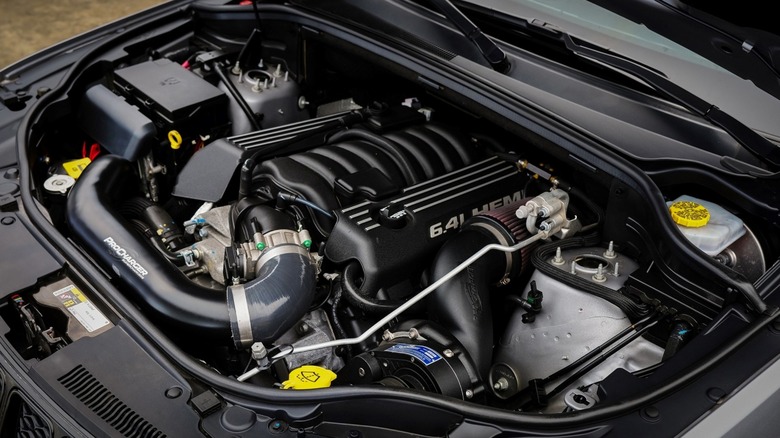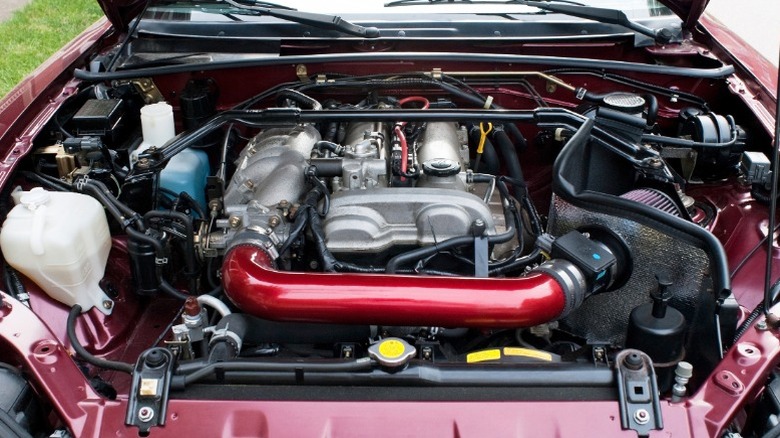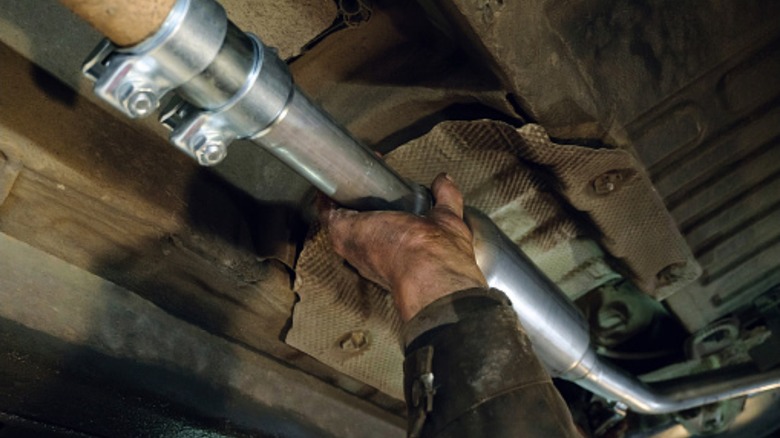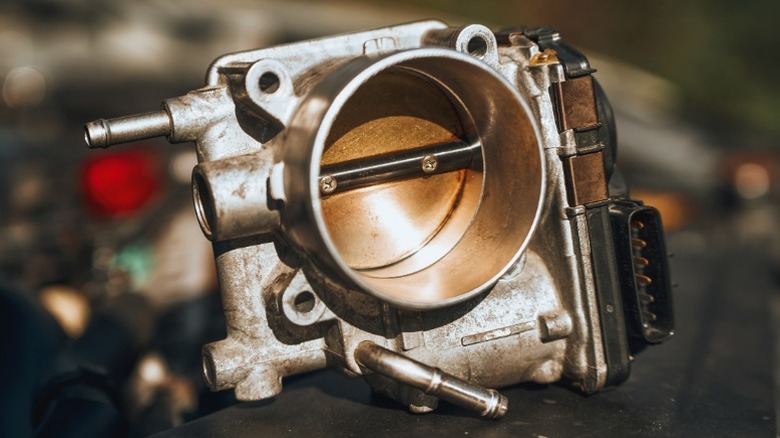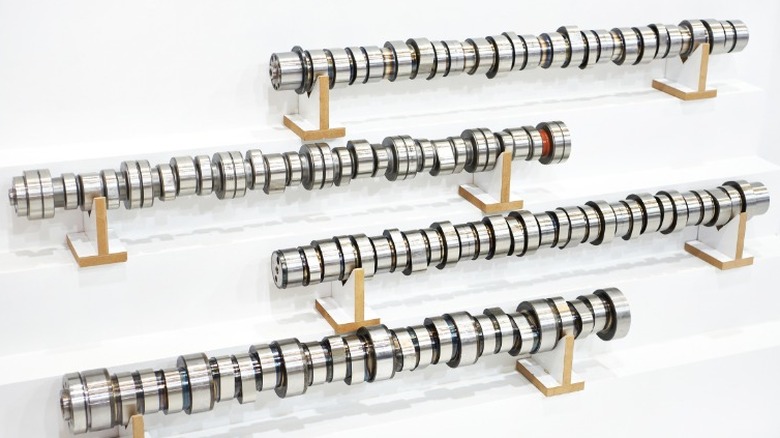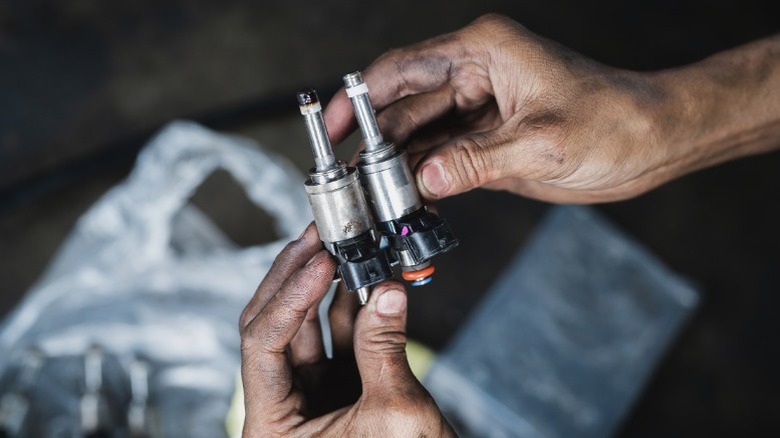5 Engine Car Parts To Upgrade If You Want More Horsepower
The internal combustion engines that power our vehicles have come a long way in the past several decades. Not only have they become more efficient and better for the environment, but car engines have also gotten significantly more powerful than they were in years past. Since the 1980s, cars have seen their horsepower outputs increase by extremely large margins. At the same time, emissions have gone down and gas mileage has gone up. That's all great, but what if you want even more horsepower?
Fortunately, there are a lot of different ways to get more horsepower out of your car. Many of those methods involve installing aftermarket upgrades or add-ons, including things like tuners or forced air induction systems like turbochargers or superchargers. However, you don't have to add extra components to squeeze a little bit more horsepower out of your ride. In fact, upgrading a few stock parts can go a long way toward increasing your car's power output.
As a former professional auto repair technician and a lifelong gearhead who's modified numerous vehicles, I'll break down some of the best engine parts to upgrade if you want more horsepower.
Enhancing your air intake can make a big difference
When it comes to increasing horsepower outputs, one of the best and most affordable ways to boost your car's performance is to install a cold air intake system. In fact, replacing the stock air intake with a cold air intake system is often one of the very first modifications many enthusiasts perform. It's relatively quick and easy to install a cold air intake, and doing so can add up to 20 horsepower, depending on your make, model, and the type of intake you install.
Cold air intake systems work by replacing the stock intake tubing, which often twists and turns around various engine components, and the stock engine air filter with straighter, higher-quality components. The straighter tubing found in most cold air intake systems helps prevent airflow restriction and turbulence, contributing to increases in power. Additionally and as the name implies, cold air intake systems draw in denser, colder air from farther away from the engine. That cooler and denser air has a higher oxygen content than hot air, which causes the car to increase the amount of fuel sent to the engine and results in moderate performance boosts.
As mentioned, cold air intake systems are relatively easy to install. While the exact steps will depend on your make and model, generally, you'll only need to remove a few bolts and hose clamps to disconnect the stock intake and then follow the reverse steps to install the improved cold air intake. These systems are also relatively affordable, and you can typically find a solid cold air intake for around $150 to $300.
The exhaust system could be holding your car back
Another engine part that you can upgrade if you're interested in increasing your horsepower is the exhaust system. Remember that internal combustion engines rely on small explosions to power your car. The exhaust system is responsible for expelling the byproducts of those explosions out of the engine. These fumes and gasses are commonly referred to as emissions, and it's vital that the exhaust system removes them from the combustion chambers to prevent choking the engine on its own waste.
The problem is that stock exhaust systems often don't do the most efficient job of expelling those waste gasses. That's especially true if you've already modified your engine with something like a cold air intake system. As more air enters the engine, more exhaust gasses will need to leave. Stock exhaust manifolds, in particular, frequently can't handle the added stress and develop a condition known as back pressure.
Back pressure is an accumulation of exhaust gasses that can stifle the engine and impede the normal flow of fuel and exhaust fumes, causing a drop in power and fuel economy. To circumvent this issue, many gearheads and tuners elect to replace their stock exhaust systems with aftermarket performance upgrades. Simply replacing the manifold with exhaust headers is a solid start. However, if you want to go a bit further, you can replace the entire exhaust system, from the manifold to the tailpipe. Alternatively, you can install some headers and selectively upgrade parts of the exhaust system, like the catalytic converters and muffler. In these scenarios, a cat back exhaust system is a popular and solid option.
A throttle body upgrade is a good secondary move
If you want to boost your car's horsepower output by upgrading stock components, the throttle body is another solid part to consider replacing. The throttle body is located between the air intake system and the engine, and its job is to control the amount of air that enters the combustion chambers. It accomplishes this feat by using a butterfly valve that the driver controls via the gas pedal — the harder you push on the pedal, the wider the valve opens to allow more air into the engine, translating to increased speed and power.
Upgrading the throttle body allows your engine to suck in more air, which can result in performance boosts. It's especially important to upgrade the throttle body if you've already modified the air intake system. As mentioned, an upgraded intake, like a cold air intake, will force more air into the engine. If you fail to upgrade the throttle body, the stock part may be too small to accommodate that extra air, resulting in a choke point and inefficient performance.
Opting to replace the stock throttle body with a larger performance version can solve that issue by allowing more air to enter the engine. However, it's worth noting that upgrading your throttle body on its own most likely won't result in massive horsepower increases. That said, upgrading the throttle body in conjunction with another upgrade, like a cold air intake system, can help boost your car's performance by up to 25 horsepower, and the larger performance part can also improve things like gas pedal response and acceleration.
Replacing the camshafts can add major horsepower
Another effective way to boost your car's horsepower involves upgrading the camshaft or camshafts. Most vehicles have one or two camshafts, but some have up to four. In the case of pushrod engines, a single camshaft is usually located inside the engine block, while overhead cam (OHC) motors — like SOHC and DOHC engines — feature one or more camshafts located above the block inside the cylinder head. The camshaft connects to the crankshaft via a timing belt, which synchronizes the movement of the camshaft and the crankshaft.
The camshaft's job is to control the opening and closing of the engine's exhaust and air intake valves. It does this by using offset lobes to actuate valves as it spins. Every internal combustion engine has at least one camshaft. They're extremely durable components and are designed to last for decades. However, many drivers choose to upgrade their camshaft(s) to improve horsepower.
Aftermarket and upgraded camshafts can improve your performance in a few ways. Some of the most common ways that upgraded cams can boost your horsepower include increasing airflow by opening the intake valves for longer periods and improving engine compression. Depending on the type of camshaft upgrade and any other modifications you've already installed, replacing your cams with larger performance versions can yield up to 100 extra horsepower.
New fuel injectors can add significant power
Considering that internal combustion engines run on fuel, it may not surprise you to learn that upgrading the fuel system is a solid way to glean a bit more horsepower from your car. When it comes to upgrading the fuel system, you don't have to do it all at once. In fact, one of the best places to start is in the engine bay with the fuel injectors. Fuel injectors are responsible for shooting precise amounts of gasoline or diesel into your engine's combustion chambers, providing the fuel necessary for the explosions that power your car. However, the stock fuel injectors that come in your vehicle are often limited. Installing an upgraded set can help increase your horsepower, and it's an especially wise modification to make following a throttle body upgrade.
That's because when you upgrade to a larger throttle body, you're allowing more air into the engine, which can help create more power. However, to reap the full benefits of your modified air intake and throttle body, the engine will need extra fuel, too. A popular way to give your engine more fuel is to install larger, performance fuel injectors. Larger injectors will introduce more fuel into the combustion chambers, allowing the engine to produce greater horsepower . Depending on your vehicle, its engine, and the type of upgrades you install, new fuel injectors can result in as much as 20% more horsepower.
